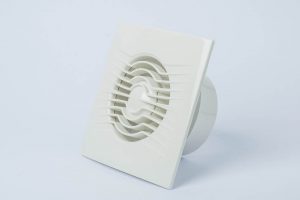A bathroom can be a breeding ground for so many odours and bacteria. If these foreign particles persist for a more extended amount of time, they will get mixed up and adversely affect an individual.
You would no longer be able to share a bathroom with anyone else. Single-use would warrant thorough cleaning and scrubbing, as well as opening the ducts to force the particles out.
But thankfully, a beautiful invention called an extractor fan exists! Not only does it help get rid of the odours quickly, but it also keeps your bathroom safe for multiple uses.
Pair it up with a freshener, and your bathroom might be comparable to heaven on earth!
You would be surprised to know that this mechanical device is one of the most effortless appliances to clean. You don’t even require a professional! But before we dive right into it, let us reiterate what the bathroom extractor fan does.
Contents
Key Takeaways
- An extractor fan, or an exhaust fan, is essential for removing odours and moisture in bathrooms and kitchens.
- Extractor fans come in various types, such as inline, axial, and centrifugal, each with its method of expelling contaminated air.
- Regular maintenance is crucial to clean an extractor fan, turn off the power, remove the fan cover, dust and scrub the interior, and ensure all components are thoroughly dry before reassembly.
What Is an Extractor Fan?
An extractor fan is often referred to as an exhaust fan. You can find it in kitchens as well as bathrooms. The primary function it offers is to blow away the odour and moisture present in the room.
An extractor fan acts as a ventilation device and uses metal ducts or flexible tubes. These ducts or pipes act as gateways to get rid of the air indoors. As a result, the air quality increases, and the cycle continues.
It is a staple in any bathroom since built-up moisture and odour can be detrimental and stink up the entire place.
How Does an Extractor Fan Work?
A typical exhaust fan runs on electricity and is usually wired to an electric circuit used for lights. It requires manual control, and a switch is provided nearby to turn it on and off as needed.
As you turn on the fan, it sucks up the indoor air through the enclosure present in the structure. Metal ducts or flexible tubes are then used to transport this air outside. These ducts lead to an opening on the roof or sidewalls.
A shutter with horizontal slats marks the exit point of an extractor fan. This structure acts as a source of blockage when the fan is not in use.

What Are the Parts of An Exhaust Fan?
It is essential to know the basic components of an exhaust fan before diving into the setup.
An exhaust fan consists of four essential parts:
- An “air intake” area is used to suck the indoor air and transport it outside through the duct.
- Metal ducts transport the air above and move air from one place to another.
- Air cleaning devices are used to eliminate any contaminant present in the air. Additionally, these devices can also trap the said impurities.
- Discharge stacks are used to expel the impurities present in the air.
Do Extractor Fans Offer Variety?
These exhaust fans are not limited to a single design or style. They come in three main types – inline, axial, and centrifugal.
As the name suggests, inline fans are installed with the ductwork and fulfil the mentioned purpose of expelling contaminated air. Also known as remote mounted fans, these appliances fit bathrooms, kitchens, and other wet areas.
An axial fan houses a shaft used for running the fan. The extracted air is made to move parallel to these shafts as it is expelled out. Axial fans utilize centrifugal force to remove air and spin it outwards by deflection.
Lastly, the centrifugal fan consists of a motor and an impeller. The latter is used for sucking air inside the engine. The air is sucked in and then blown out at a ninety-degree angle.
How Do You Fit an Extractor Fan?
Now that we’ve covered everything related to these handy structures, you can try fitting one! Don’t forget, these are an essential part of your bathroom, and hence, care needs to be taken. Now on to the setting up part!
- Plan out the fitting process. Make sure that there is enough space for the fan you choose. Check out the circuit to which it is to be connected.
- Finalize the spot and mark it with a pencil. Make sure that the site is cleared of insulation. Drill carefully and get rid of the waste in an organized manner.
- Take the vent out and carefully attach it with proper fittings. As a result, the vent can be placed and reinforced to the duct pipe in the loft. Mark the spots where you will secure the vent to the ceiling.
- It’s time to attach the vent. Carefully drill holes at the marked areas and secure the vent. Use screwdrivers to fit the vent in firmly. You can either use one hand to keep the vent in place or take the help of someone.
- Please take out your fan and hold it against the loft. It will give you an idea of where you should drill the holes. Additionally, you can also secure the position of the fan. After marking all the necessary points, use a screwdriver to reinforce the fan.
- Attach the ducting to the vent, and secure the interior part of the fan. You can ensure the exterior part of the fan by using another ducting.
- Attach all the electrical connections with proper care. You don’t want your exhaust fan to be interfering with your power supply.
- Contact a professional if you get stuck during any part of the tutorial. It’s always better to play safe than take a risk.

Cleaning the Extractor Fan
Bathroom fans may accumulate a lot of dust as they keep working day in and day out. You must maintain them periodically. Let’s look at some common steps to help keep them clean.
- Firstly, turn off the power. Since an extractor fan runs on electrical connections, water will be detrimental. It is recommended to turn off the main switch before you begin your cleaning process.
- Starting from the outside, first, remove the fan cover. This means that you’ll have to unscrew the fittings and save them carefully. Soak this cover into soapy water poured into a container, and leave it be.
- The unit is now exposed with the removal of the fan cover. Use a duster to dust the inside of your exhaust fan and make sure to reach the entire structure. Dust may accumulate in loads and affect the working.
- Fill a container with soapy water and use it to scrub the insides. Ensure that the scrubbing cloth isn’t dirty and reaches the entire unit.
- After you’ve soaked and scrubbed, it’s time to let the components dry. Please keep them in a well-aerated place for a few hours. Do not attach them until they are completely dry.
- Make sure to repeat this activity once every month to keep your extractor fan clean and in good condition.
Heat Pump Source: Reliable Heating and Cooling Solutions
At Heat Pump Source, we take pride in our unwavering commitment to serving the UK with top-tier HVAC solutions. From the efficiency of heat pumps and the cool relief of air conditioning to the warmth of boilers, radiators, and underfloor heating, our dedicated team is always at the forefront of innovation. We understand the unique needs of every household and business, and we strive to provide dependable health and cooling products and services that are tailored just for you. Ensuring your comfort and satisfaction is our utmost priority. Whether you have questions, need guidance, or require support, we’re always here to assist. Please don’t hesitate to contact us; we’re eager to be of service.
Conclusion
Lo and behold! Your exhaust fan has now been fitted with utmost perfection. You’ve also learned how to clean it inside out!
These appliances usually come with a manufacturer’s guide or instructions. It would help to go through those pages before attempting the fitting and cleaning. Not only will the guide give you a detailed explanation, but it will also list some common problems.
Make sure you regularly maintain the extractor fan. Keep cleaning and dusting it regularly. Switch it off when it’s not being used, or it will consume a lot of electricity.
Keep the area of the fan relatively free from any clutter. If required, you can install it in a separate and secluded place in your bathroom. Just remember that it should be able to access the entire bathroom.
About the Author
At Heat Pump Source, our articles are the product of a collaborative effort among a team of highly skilled HVAC experts. Our dedicated professionals, hailing from diverse backgrounds in heating, ventilation, air conditioning, and refrigeration, contribute their extensive knowledge and experience to every piece of content. This multidisciplinary approach ensures comprehensive coverage. Our commitment is to deliver authoritative, reliable, and tailored advice to meet the unique needs of every household and business across the UK.


